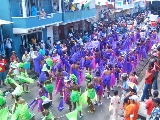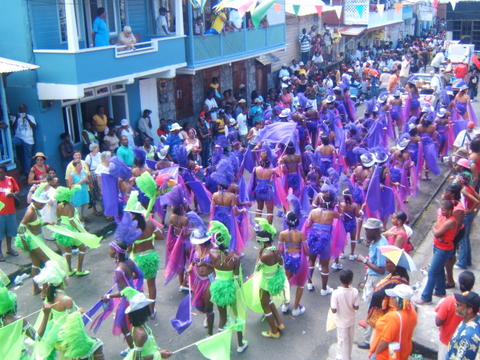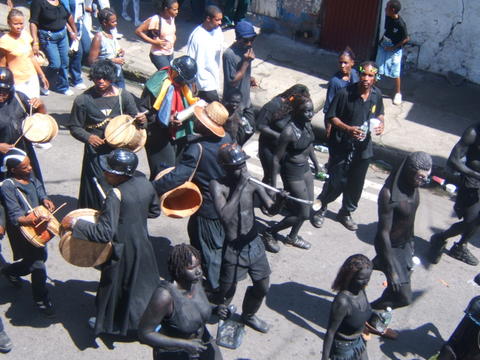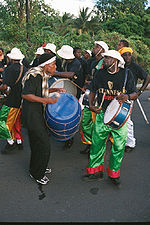
Culture of Dominica
Encyclopedia
Dominica
is home to a wide range of people. Although it was historically occupied by several native tribes, the Arawaks and Kalinago Carib tribes remained by the time Europe
an settlers reached the island. 'Massacre' is a name of a river dedicated to the murders of the Native villagers by French and British settlers, because the river ran red with blood for days. Each (French and British) claimed the island and imported slaves from Africa
. The remaining Caribs now live on a 3700 acres (15 km²) Carib Territory
on the east coast of the island. They elect their own chief.
Dominica is often seen as a society that is migrating from collectivism to that of individualism. The economy is a developing one that previously depended on agriculture. Signs of collectivism are evident in the small towns and villages which are spread across the island.
Dominican cuisine is similar to that of other Caribbean countries. Common main courses comprise meat (usually chicken, but can be goat, lamb, or beef) covered in sauce. The sauces are either spicy pepper sauces, or concoctions made from local fruit. A huge variety of local fruit, from tamarind to passion fruit, are served on the island, usually in juice or sauce form. Soursop is peeled and eaten raw. Sorrel, a red flower that only blooms around Christmas
, is boiled into a bright red drink.
place names feature as often as English
; Africa
n language, foods and customs mingle with European traditions as part of the island's Creole
culture; and the Caribs still carve dugouts (canoes), build houses on stilts and weave distinctive basketwork. Rastafarian and Black pride influences are also common. The Bahá'í Faith in Dominica
is about 1% of the population.
With an almost 80% Roman Catholic population, conservative traditional values are strong. Family holds an important place in Dominican society, so much so that a government poster warning Dominicans of the dangers of transporting illegal drugs lists separation from family (followed by imprisonment and loss of life) as the number one deterrent to the crime.
about 400 BC
, when the Arawaks, a group of peaceful hunter-gatherers, established villages after island-hopping across the Eastern-Caribbean
. The more aggressive hunter-gatherers, the Carib Indians (both descendants of the Ciboney tribe), annihilated the Arawaks and took hold of the island. Most native Caribbean people on other Caribbean islands were mostly killed by European colonists. The local Dominican Caribbean natives were able to hide in areas which were hard for European soldiers to find. The English Queen granted a 3700 acres (15 km²) territory in east coast of Dominica for the native Caribbeans in 1903. Today, there are only 3000 Caribs remaining after years of brutal treatment by the Spanish, French and English. They live in eight villages, and they elect their own chief.
On the east side of the island, the descendants of the Carib Indians continued to practise their time-honoured culture and crafts of canoe building and basket weaving. Their society, however, has developed and modernised. The Amerindians' influence remains on the island through their artifacts and the sounds of modern language. For example the word hurricane originated from the Amerindian word huracan.
passed by the island he did give Dominica
its name, but left no other settlers on the island. It would be years before English
and French
settlers came to the island. These two European superpowers fought relentlessly for the island, and their cultures each took hold. However, African slaves have also left an indelible mark on the island.
French influences include the island's native language, a creole
, food, and many location names. The British government won the island, and the influences of government as well as the official language are distinctly theirs. Africans also influenced the creole and food, as well as the distinctive local style of dress.


Each year, Dominicans celebrate the Catholic Carnival, a festival held for three days before Ash Wednesday. Due to the country's French heritage, a majority of citizens are Catholic, but many non-Catholics also celebrate Carnival. Activities include the Calypso Monarch Competition, Carnival Queen Pageant, and Carnival parades and parties.
 Music and dance are important facets of Dominica's culture. The annual independence celebrations show an outburst of traditional song and dance preceded since 1997 by weeks of Creole expressions such as "Creole in the Park" and the "World Creole Music Festival".
Music and dance are important facets of Dominica's culture. The annual independence celebrations show an outburst of traditional song and dance preceded since 1997 by weeks of Creole expressions such as "Creole in the Park" and the "World Creole Music Festival".
Dominica gained prominence on the international music stage when in 1973, Gordon Henderson founded the group Exile One
and an original musical genre which he coined "Cadence-lypso
" which paved the way for modern Creole music.
The 11th annual World Creole Music
Festival was the first activity held there since its completion on October 27, 2007, part of the island's celebration of independence from Great Britain on November 3. A year-long reunion celebration began in January 2008 marking 30 years of independence.
Dominica
Dominica , officially the Commonwealth of Dominica, is an island nation in the Lesser Antilles region of the Caribbean Sea, south-southeast of Guadeloupe and northwest of Martinique. Its size is and the highest point in the country is Morne Diablotins, which has an elevation of . The Commonwealth...
is home to a wide range of people. Although it was historically occupied by several native tribes, the Arawaks and Kalinago Carib tribes remained by the time Europe
Europe
Europe is, by convention, one of the world's seven continents. Comprising the westernmost peninsula of Eurasia, Europe is generally 'divided' from Asia to its east by the watershed divides of the Ural and Caucasus Mountains, the Ural River, the Caspian and Black Seas, and the waterways connecting...
an settlers reached the island. 'Massacre' is a name of a river dedicated to the murders of the Native villagers by French and British settlers, because the river ran red with blood for days. Each (French and British) claimed the island and imported slaves from Africa
Africa
Africa is the world's second largest and second most populous continent, after Asia. At about 30.2 million km² including adjacent islands, it covers 6% of the Earth's total surface area and 20.4% of the total land area...
. The remaining Caribs now live on a 3700 acres (15 km²) Carib Territory
Carib Territory
The Carib Territory or Carib Reserve is a district in the Caribbean island-nation of Dominica. It was established for the descendants of the indigenous Carib people, also known as the Kalinago, who inhabited Dominica prior to European colonization and settlement.The Carib Territory was officially...
on the east coast of the island. They elect their own chief.
Dominica is often seen as a society that is migrating from collectivism to that of individualism. The economy is a developing one that previously depended on agriculture. Signs of collectivism are evident in the small towns and villages which are spread across the island.
Dominican cuisine is similar to that of other Caribbean countries. Common main courses comprise meat (usually chicken, but can be goat, lamb, or beef) covered in sauce. The sauces are either spicy pepper sauces, or concoctions made from local fruit. A huge variety of local fruit, from tamarind to passion fruit, are served on the island, usually in juice or sauce form. Soursop is peeled and eaten raw. Sorrel, a red flower that only blooms around Christmas
Christmas
Christmas or Christmas Day is an annual holiday generally celebrated on December 25 by billions of people around the world. It is a Christian feast that commemorates the birth of Jesus Christ, liturgically closing the Advent season and initiating the season of Christmastide, which lasts twelve days...
, is boiled into a bright red drink.
The National Psyche
Dominica draws on a mix of cultures: FrenchFrench language
French is a Romance language spoken as a first language in France, the Romandy region in Switzerland, Wallonia and Brussels in Belgium, Monaco, the regions of Quebec and Acadia in Canada, and by various communities elsewhere. Second-language speakers of French are distributed throughout many parts...
place names feature as often as English
English language
English is a West Germanic language that arose in the Anglo-Saxon kingdoms of England and spread into what was to become south-east Scotland under the influence of the Anglian medieval kingdom of Northumbria...
; Africa
Africa
Africa is the world's second largest and second most populous continent, after Asia. At about 30.2 million km² including adjacent islands, it covers 6% of the Earth's total surface area and 20.4% of the total land area...
n language, foods and customs mingle with European traditions as part of the island's Creole
Creole peoples
The term Creole and its cognates in other languages — such as crioulo, criollo, créole, kriolu, criol, kreyol, kreol, kriulo, kriol, krio, etc. — have been applied to people in different countries and epochs, with rather different meanings...
culture; and the Caribs still carve dugouts (canoes), build houses on stilts and weave distinctive basketwork. Rastafarian and Black pride influences are also common. The Bahá'í Faith in Dominica
Bahá'í Faith in Dominica
The Bahá'í Faith in Dominica begins with a mention by `Abdu'l-Bahá, then head of the religion, in 1916 as Latin America being among the places Bahá'ís should take the religion to. The island of Dominica was specifically listed as an objective for plans on spreading the religion in 1939 by Shoghi...
is about 1% of the population.
With an almost 80% Roman Catholic population, conservative traditional values are strong. Family holds an important place in Dominican society, so much so that a government poster warning Dominicans of the dangers of transporting illegal drugs lists separation from family (followed by imprisonment and loss of life) as the number one deterrent to the crime.
Amerindians
The first settlers on the island arrived to the Commonwealth of DominicaDominica
Dominica , officially the Commonwealth of Dominica, is an island nation in the Lesser Antilles region of the Caribbean Sea, south-southeast of Guadeloupe and northwest of Martinique. Its size is and the highest point in the country is Morne Diablotins, which has an elevation of . The Commonwealth...
about 400 BC
400 BC
Year 400 BC was a year of the pre-Julian Roman calendar. At the time, it was known as the Year of the Tribunate of Esquilinus, Capitolinus, Vulso, Medullinus, Saccus and Vulscus...
, when the Arawaks, a group of peaceful hunter-gatherers, established villages after island-hopping across the Eastern-Caribbean
Caribbean
The Caribbean is a crescent-shaped group of islands more than 2,000 miles long separating the Gulf of Mexico and the Caribbean Sea, to the west and south, from the Atlantic Ocean, to the east and north...
. The more aggressive hunter-gatherers, the Carib Indians (both descendants of the Ciboney tribe), annihilated the Arawaks and took hold of the island. Most native Caribbean people on other Caribbean islands were mostly killed by European colonists. The local Dominican Caribbean natives were able to hide in areas which were hard for European soldiers to find. The English Queen granted a 3700 acres (15 km²) territory in east coast of Dominica for the native Caribbeans in 1903. Today, there are only 3000 Caribs remaining after years of brutal treatment by the Spanish, French and English. They live in eight villages, and they elect their own chief.
On the east side of the island, the descendants of the Carib Indians continued to practise their time-honoured culture and crafts of canoe building and basket weaving. Their society, however, has developed and modernised. The Amerindians' influence remains on the island through their artifacts and the sounds of modern language. For example the word hurricane originated from the Amerindian word huracan.
Other Settlers
When Christopher ColumbusChristopher Columbus
Christopher Columbus was an explorer, colonizer, and navigator, born in the Republic of Genoa, in northwestern Italy. Under the auspices of the Catholic Monarchs of Spain, he completed four voyages across the Atlantic Ocean that led to general European awareness of the American continents in the...
passed by the island he did give Dominica
Dominica
Dominica , officially the Commonwealth of Dominica, is an island nation in the Lesser Antilles region of the Caribbean Sea, south-southeast of Guadeloupe and northwest of Martinique. Its size is and the highest point in the country is Morne Diablotins, which has an elevation of . The Commonwealth...
its name, but left no other settlers on the island. It would be years before English
English people
The English are a nation and ethnic group native to England, who speak English. The English identity is of early mediaeval origin, when they were known in Old English as the Anglecynn. England is now a country of the United Kingdom, and the majority of English people in England are British Citizens...
and French
French people
The French are a nation that share a common French culture and speak the French language as a mother tongue. Historically, the French population are descended from peoples of Celtic, Latin and Germanic origin, and are today a mixture of several ethnic groups...
settlers came to the island. These two European superpowers fought relentlessly for the island, and their cultures each took hold. However, African slaves have also left an indelible mark on the island.
French influences include the island's native language, a creole
Antillean Creole
Antillean Creole is a creole language with a vocabulary based on French. It is spoken primarily in the Lesser Antilles. Its grammar and vocabulary also include elements of Carib and African languages. Antillean Creole is related to Haitian Creole, but has a number of distinctive features; they are...
, food, and many location names. The British government won the island, and the influences of government as well as the official language are distinctly theirs. Africans also influenced the creole and food, as well as the distinctive local style of dress.
Carnival


Each year, Dominicans celebrate the Catholic Carnival, a festival held for three days before Ash Wednesday. Due to the country's French heritage, a majority of citizens are Catholic, but many non-Catholics also celebrate Carnival. Activities include the Calypso Monarch Competition, Carnival Queen Pageant, and Carnival parades and parties.
Music

Dominica gained prominence on the international music stage when in 1973, Gordon Henderson founded the group Exile One
Exile One
Exile One is a legendary musical group of the 1970s from Dominica based in Guadeloupe. Gordon Henderson is the leader and founder of the famous musical group "Exile One" and the one who coined the name "Cadence-lypso" for a genre of music that revolutionized modern creole music worldwide....
and an original musical genre which he coined "Cadence-lypso
Cadence-lypso
Cadence-lypso, popularized as simply Cadence is a cultural music of Dominica based in Guadeloupe in the early 1970s. Cadence-lypso is a fusion of Dominican and Caribbean/Latin rhythms and has totally revolutionized the music scence in its genre, and it has now become the main dance Music of...
" which paved the way for modern Creole music.
The 11th annual World Creole Music
Creole music
Creole music applies to two genres of music from south Louisiana: Creole folk and Creole. Creole folk dates from the 18th century or before, and it consists primarily of folk songs. Many were published, and some found their way into works by Louisiana composers such as Louis Moreau Gottschalk,...
Festival was the first activity held there since its completion on October 27, 2007, part of the island's celebration of independence from Great Britain on November 3. A year-long reunion celebration began in January 2008 marking 30 years of independence.

